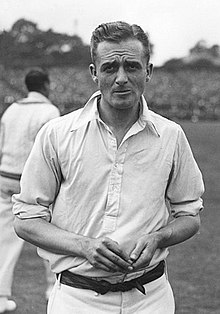
Back جورج ماكولاي Arabic چورچ ماكاولاى ARZ জর্জ ম্যাকাউলি Bengali/Bangla George Macaulay French जॉर्ज मॅकोले Marathi ஜோர்ஜ் மெக்கோலே Tamil جارج میکالے Urdu
 Macaulay at the third Test vs. Australia at Headingley Stadium in 1926 | ||||||||||||||||||||||||||||||||||||||||
| Personal information | ||||||||||||||||||||||||||||||||||||||||
|---|---|---|---|---|---|---|---|---|---|---|---|---|---|---|---|---|---|---|---|---|---|---|---|---|---|---|---|---|---|---|---|---|---|---|---|---|---|---|---|---|
| Full name | George Gibson Macaulay | |||||||||||||||||||||||||||||||||||||||
| Born | 7 December 1897 Thirsk, Yorkshire, England | |||||||||||||||||||||||||||||||||||||||
| Died | 13 December 1940 (aged 43) Sullom Voe, Shetland Islands, Scotland | |||||||||||||||||||||||||||||||||||||||
| Height | 5 ft 10.5[1] in (1.79 m) | |||||||||||||||||||||||||||||||||||||||
| Batting | Right-handed | |||||||||||||||||||||||||||||||||||||||
| Bowling | Right-arm medium-fast Right-arm off spin | |||||||||||||||||||||||||||||||||||||||
| Role | Bowler | |||||||||||||||||||||||||||||||||||||||
| International information | ||||||||||||||||||||||||||||||||||||||||
| National side | ||||||||||||||||||||||||||||||||||||||||
| Test debut (cap 211) | 1 January 1923 v South Africa | |||||||||||||||||||||||||||||||||||||||
| Last Test | 22 July 1933 v West Indies | |||||||||||||||||||||||||||||||||||||||
| Domestic team information | ||||||||||||||||||||||||||||||||||||||||
| Years | Team | |||||||||||||||||||||||||||||||||||||||
| 1920–1935 | Yorkshire | |||||||||||||||||||||||||||||||||||||||
| Career statistics | ||||||||||||||||||||||||||||||||||||||||
| ||||||||||||||||||||||||||||||||||||||||
Source: Cricinfo, 15 March 2010 | ||||||||||||||||||||||||||||||||||||||||
George Gibson Macaulay (7 December 1897 – 13 December 1940) was a professional English cricketer who played first-class cricket for Yorkshire County Cricket Club between 1920 and 1935. He played in eight Test matches for England from 1923 to 1933, achieving the rare feat of taking a wicket with his first ball in Test cricket. One of the five Wisden Cricketers of the Year in 1924, he took 1,838 first-class wickets at an average of 17.64 including four hat-tricks.
A leading member of the Yorkshire team which achieved a high level of success in the time he played, Macaulay was a volatile character who played aggressively. He left a job at a bank to become a professional cricketer, making his first-class debut aged 23 as a fast bowler. Meeting limited success, he altered style to deliver off spin in addition to his pace bowling. This proved so effective that he was chosen to play for England in Test matches. However, his perceived poor attitude towards the game, and an unsuccessful match in the 1926 Ashes probably prevented him playing more Tests. His form slumped following injuries in the late 1920s, but a recovery in the early 1930s led to a recall by England, although he broke down in his second match back. Another injury in 1934 made cricket difficult for him and his first-class career ended in 1935, although he continued playing club cricket until the Second World War. A pilot officer in the Royal Air Force, he died of pneumonia on active service in the Second World War.
- ^ "Answers to Correspondents". Sheffield Daily Telegraph/British Newspaper Archive. Sheffield. 27 June 1923. p. 7.